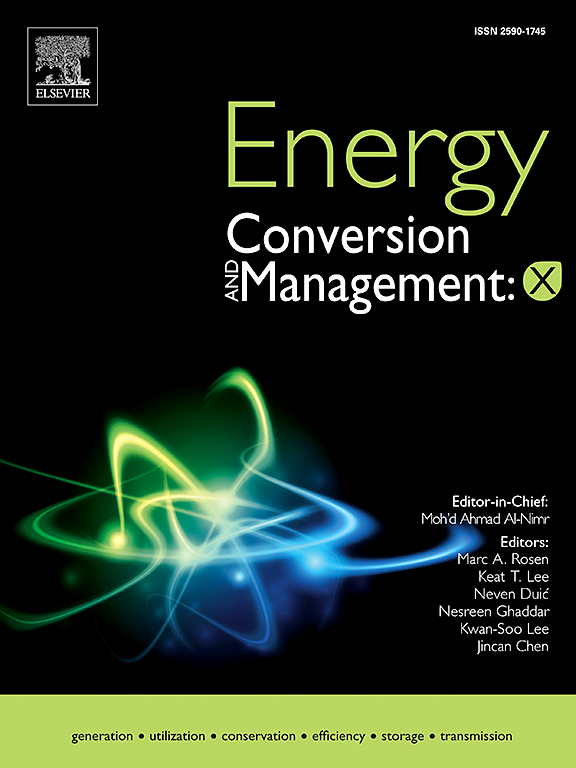Design and technical assessment of photovoltaic and vanadium redox flow battery systems for residential buildings based on time-of-use electricity pricing strategy
IF 10.9
1区 工程技术
Q1 ENERGY & FUELS
引用次数: 0
Abstract
This study investigated the technical feasibility of a photovoltaic and vanadium redox flow battery (PV-VRFB) system for residential power supply in urban environments. A three-dimensional transient model of the VRFB unit was established using COMSOL to analyze battery performance under different current densities. The VRFB unit simulation demonstrated good agreement with experimental results, showing a relative voltage error of 1.34 %. The research focused on a typical residential community in Shenzhen, utilizing time-of-use electricity pricing as an energy management strategy. The simulation results indicated that the current density of VRFB had a significant impact on charge–discharge time, efficiency, as well as the stored and output energy. At a current density of 40 A/m2, the coulombic efficiency, voltage efficiency, and energy efficiency of the VRFB were 93.18 %, 84.77 %, and 78.99 %, respectively. Higher current densities adversely affected overall system energy performance. An increase in VRFB current density from 40 A/m2 to 60 A/m2 resulted in decreases of 2.19 % in PV self-consumption rate (PRSR) and 2.30 % in load coverage rate (LCR). The PV-VRFB system achieved annual average PV self-consumption rate and load coverage rate values of 59.40 % and 62.08 %, respectively. The PSCR and LCR values were improved by 18.07 % and 14.18 % compared to the PV-Only system. The research results show that, in the current system, the levelized cost of energy (LCOE) is 0.7416 CNY/kWh and the dynamic payback period (DPP) is 22.65 years. Introducing a PV-VRFB system in residential areas significantly enhances renewable energy utilization, while highlighting the critical importance of controlling the VRFB current density.
基于分时电价策略的住宅光伏-钒氧化还原液流电池系统设计与技术评价
本研究探讨了光伏-钒氧化还原液流电池(PV-VRFB)系统用于城市住宅供电的技术可行性。利用COMSOL软件建立了VRFB单元的三维瞬态模型,分析了不同电流密度下的电池性能。VRFB单元仿真结果与实验结果吻合较好,相对电压误差为1.34%。本研究以深圳一个典型的住宅社区为研究对象,将分时电价作为一种能源管理策略。仿真结果表明,VRFB的电流密度对充放电时间、效率以及存储和输出能量有显著影响。在电流密度为40 a /m2时,VRFB的库仑效率、电压效率和能量效率分别为93.18%、84.77%和78.99%。较高的电流密度对整个系统的能量性能产生不利影响。VRFB电流密度从40 A/m2增加到60 A/m2,导致光伏自用率(PRSR)下降2.19%,负载覆盖率(LCR)下降2.30%。光伏- vrfb系统的年平均光伏自用率和负荷覆盖率分别达到59.40%和62.08%。与纯pv相比,PSCR和LCR分别提高了18.07%和14.18%。研究结果表明,当前系统的平准化能源成本(LCOE)为0.7416元/千瓦时,动态投资回收期(DPP)为22.65年。在居民区引入PV-VRFB系统可以显著提高可再生能源的利用率,同时也强调了控制VRFB电流密度的重要性。
本文章由计算机程序翻译,如有差异,请以英文原文为准。
求助全文
约1分钟内获得全文
求助全文
来源期刊

Energy Conversion and Management
工程技术-力学
CiteScore
19.00
自引率
11.50%
发文量
1304
审稿时长
17 days
期刊介绍:
The journal Energy Conversion and Management provides a forum for publishing original contributions and comprehensive technical review articles of interdisciplinary and original research on all important energy topics.
The topics considered include energy generation, utilization, conversion, storage, transmission, conservation, management and sustainability. These topics typically involve various types of energy such as mechanical, thermal, nuclear, chemical, electromagnetic, magnetic and electric. These energy types cover all known energy resources, including renewable resources (e.g., solar, bio, hydro, wind, geothermal and ocean energy), fossil fuels and nuclear resources.
 求助内容:
求助内容: 应助结果提醒方式:
应助结果提醒方式:


